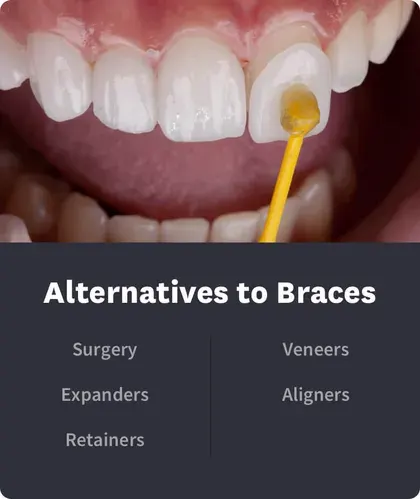Alternatives to Braces in 2022: What the Science Says.

Table of Contents
- Braces Alternatives
- Aligners
- Braces Options Explained
- Compare
- References
Misaligned teeth can keep us from showing off our pearly whites to the people we love. But some people are scared of the cost and time investment involved in straightening their smile. They think ugly metal braces are their only option.
If your smile is subpar, but you don't want the hassle and expense of standard braces, you're in luck. There are plenty of alternatives to conventional braces in 2022. A little research could help you find the solution that's just right for your teeth.
Braces alternatives to consider in 2022.
By the time you reach adulthood, your teeth are firmly anchored to your skull and jaw. Tiny ligaments hold teeth to your gums, and if you attend to your dental health, those connections are strong. You can't push your teeth into a new position without a little help. But there are plenty of options out there that don't involve wires and brackets.

If you want to straighten your teeth without braces, you could try:
If your smile is marred by one missing or chipped tooth, or you have a cluster of teeth in one spot that don't look quite right, a surgeon can help. Dental surgeons can pop crowns on crooked teeth, use bridges to replace a section of poor teeth, or use contouring solutions to ease rough patches.
If your smile is off-kilter due to a narrow or shallow upper jaw, dentists can apply a device to the roof of your mouth that slowly pushes your teeth apart. This device is invisible, unless people look closely for a band around your back teeth. Over time, it’ll make the needed space in your mouth. Generally, these are only used in children, not adults.
These devices are made to keep your teeth in place after you're done with braces. But some people use this technology to straighten very minor issues while skipping the braces altogether.
This is a cosmetic procedure, dentists explain, and it's a good option for people who decline any other tooth-straightening method. Experts adhere a tiny bit of porcelain to the front of your tooth, giving the appearance of straight teeth. Veneers are most often used to close tiny gaps or correct small misalignments between teeth.
All of these options require working with a dental professional, and they all come with risks. Signing up for veneers, for example, means allowing a dentist to remove some of the enamel from your teeth to make room for the coverings. Enamel is your tooth’s natural protection, so this is understandably an extreme step. You won’t be able to return to your natural teeth later since they are filed down to make room for the veneers.
If you’d like to protect your smile without braces, but these options seem a little extreme, aligners can be a good choice.
Aligners give you the opportunity to move your teeth quickly while spending less money, but unlike braces, which tend to pull your teeth into position, aligners gently push and twist teeth into place.
How do aligners work?
Dental aligners are similar to braces. Treatment begins with an examination of your teeth, either in person or online. Then, treatment teams map out what your ideal smile should look like.
But unlike braces, clear aligners are trays that slide onto your teeth. They're not glued on, like braces, and you can take them off to brush your teeth and floss.
Aligners move your teeth in stages, like braces. Every week or two, you'll switch to a new aligner tray that applies pressure to your teeth.
It's this pressure that sets aligners apart from braces. Since the product covers your tooth from base to crown, it applies gentle and consistent pressure. If braces pull your teeth from one attachment point, aligners rotate your teeth from all angles.
Dentists say aligners really do work, and they're best for teeth that are:
Mildly or moderately crowded.
Incorrectly spaced.
Poorly placed in front, while the back teeth fit together properly already.
Misaligned in just one or two dimensions.
But to get the benefit of aligners, you'll need to follow your treatment plan properly. That means you'll need to wear your devices the majority of the time. You can and should take them out to eat and drink. But otherwise, they should remain on your teeth. Aligner companies will specify the minimum number of hours the trays must be worn per day, and it’s usually a high number like 20 to 23 hours.
You'll also need to follow your schedule regarding tray changes. Skipping those steps can lead to slower movement.
Aligners may hurt less than braces, but that doesn't mean the tools don't work. Every time you put them on your teeth, you are applying gentle pressure that twists and rotates your teeth into the ideal position. Within a few months, you could have the smile you've been dreaming of.
After your formal treatment is complete, you'll need to wear retainers. The ligaments that attach your teeth to deeper structures might pull your teeth back to their older spots. Retainers give your mouth more time to stretch those ligaments, so the change in your smile persists.
Your braces options explained.
It's critical to understand all of your smile-improving options. And that means we should dig into braces.
Braces remain the best way to address complex, significant smile changes. If you're missing teeth, or your smile requires intense revisions before you can show off your pearly whites with confidence, you might need braces.
There are many different types of braces. You can choose from:
Ceramic braces. Brackets are clear or tooth-colored, and they're connected with wire.
Lingual braces. Brackets attach to the back of your teeth, so they are tough to see when you smile.
Metal braces. These are the traditional choice. Brackets are metal, and they're glued to the front of teeth.
Lingual and ceramic braces are much more expensive than their metal counterparts. Lingual braces, for example, can be almost five times more expensive than metal tools, experts say.
Compare.
Should you use braces or another option? We've gathered up all the data in one chart, so you can investigate your choices at a glance.
| Braces | Aligners | |
|---|---|---|
| Treatment timelines | 1 to 3 years | 1 year or less |
| Cost | $5,000 to $7,500 | $5,000 for in-office aligners; about $2,000 for direct-to-consumer aligners |
| Covered by insurance? | Metal versions only, depending on the policy | Reimbursement from insurance companies after consumers make payments |
| Ideal customers | Significant corrections needed | Mild to moderate corrections needed |
| Risks | Hard to clean, which can lead to gingivitis or tooth decay | Temptation to leave the tools out, which can lead to slow treatment timelines |
| Benefits | Help for significant smile issues | Less pain, quicker treatment, and lower costs |
